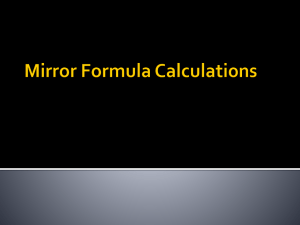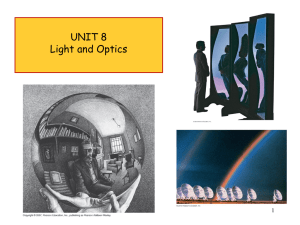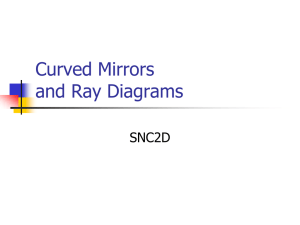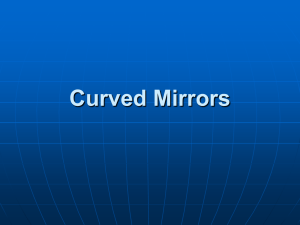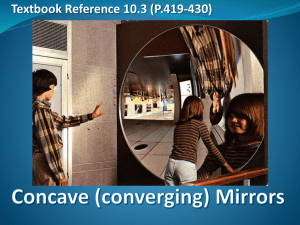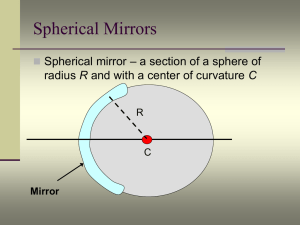Image Formation & Optical Instruments
advertisement
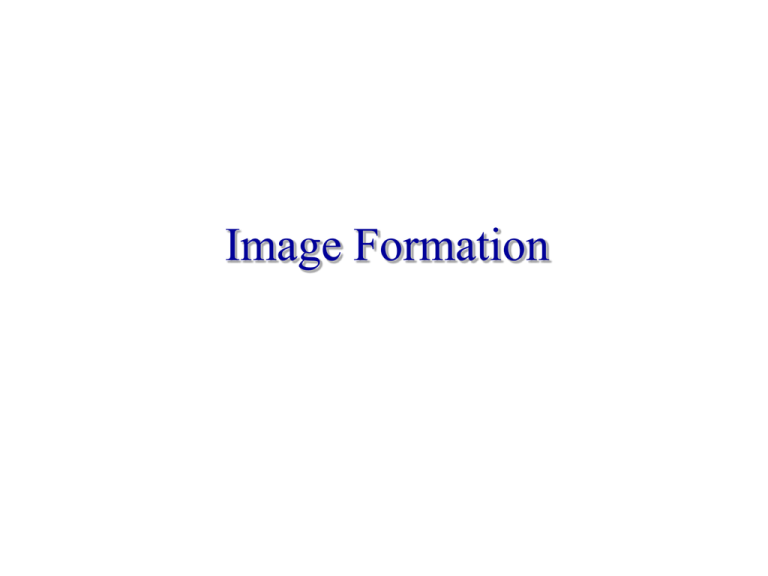
Image Formation Image Formation We will use geometrical optics: light propagates in straight lines until its direction is changed by reflection or refraction. When we see an object directly, light comes to us straight from the object. When we use mirrors and lenses, we see light that seems to come straight from the object but actually doesn’t. Thus we see an image (of the object), which may have a different position, size, or shape than the actual object. Images Formed by Plane Mirrors When we use mirrors and lenses, we see light that seems to come straight from the object but actually doesn’t. Thus we see an image, which may have a different position, size, or shape than the actual object. object image virtual image (the ray reaching your eye doesn’t really come from the image) But…. the brain thinks the ray came from the image. Images Formed by Plane Mirrors You can locate each point on the image with two rays: 1. A ray normal to the mirror object image Image is reversed front to back Images Formed by Plane Mirrors You can locate each point on the image with two rays: 1. A ray normal to the mirror 2. The ray that reaches the observer’s eye object image Image is reversed front to back Images Formed by Plane Mirrors You can locate each point on the image with two rays. object image Images Formed by Plane Mirrors The distance from the image to the mirror equals the distance from the object to the mirror: d = d d object d image Also, the height of the image equals the height of the object Images Formed by Plane Mirrors Properties of Mirror Images Produced by Plane Mirrors • The distance from the image to the mirror equals the distance from the object to the mirror: d = d • The mirror image is upright but reversed right to left • The mirror image is reversed front to back • The mirror image is the same size as the object A flower has a height h, and is at a distance d, from a plane mirror. An observer is at table level, a distance d behind the flower. Find y as a function of h Parabolic Mirrors • Shape the mirror into a parabola of rotation (In one plane it has cross section given by y = x2). • All light going into such a mirror, parallel to the parabola’s axis of rotation, is reflected to pass through a common point - the focus. • What about the reverse? • Parabolic Mirrors • These present the concept of a focal point - the point to which the optic brings a set of parallel rays together. • Parallel rays come from objects that are very far away (and, after reflection in the parabolic mirror, converge at the focal point or focus). • Parabolas are hard to make. It’s much easier to make spherical optics, so that’s what we’ll examine next. Spherical Mirrors Concave Convex Spherical Mirrors Convex Mirror Concave Mirror A ray incident parallel to the axis reflects as if coming from the focus. A ray incident parallel to the axis reflects passing through the focus. The focal distance f is given by f = - R/2 The focal distance f is given by f = R/2 Spherical Mirrors To analyze how a spherical mirror works we draw some special rays, apply the law of reflection where they strike the spherical surface, and find out where they intersect. f c A ray parallel to the mirror axis reflects through the focal point f A ray passing through the focus reflects parallel to the axis A ray that strikes the center of the mirror reflects symmetrically A ray passing through the center of curvature c, returns on itself Image Formation Trace one ray incident parallel to the axis Trace a second ray incident through the focus The image is at the intersection of the two rays. Repeat for every point in the image. In practice only ‘head’ and ‘tail’ are needed. f c Spherical Mirrors - Concave When the object is beyond c, the image is: real (on the same side as the object), reduced, and inverted. f c Spherical Mirrors - Concave Object between c and f. f c Image is real, inverted, magnified Spherical Mirrors Object between f and the mirror. f c Image is virtual, upright, magnified The Mirror Equation h0 d0 h0 d0 R and hi di hi R di Next, 1 1 R R di d0 d0 R Then, di R di R R 1 1 1 2 d 0 di d 0 di f 1 d0 The Mirror Equation c f=R/2 f l’ l 1 1 1 ' f l l Magnification h f h’ c The magnification is given by the ratio M = h’ / h = - l’/ l Curved Mirrors mirror equation focal length magnification 1 1 1 l l' f f R/ 2 h' l' M h l Curved Mirrors Sign conventions: Distance in front of the mirror positive Distance behind the mirror negative Height above center line positive Height below center line negative Concave Convex Image With a Convex Mirror c f Here the image is virtual (apparently positioned behind the mirror), upright, and reduced. Can still use the mirror equations (with negative distances for f, c=R, and l’).

